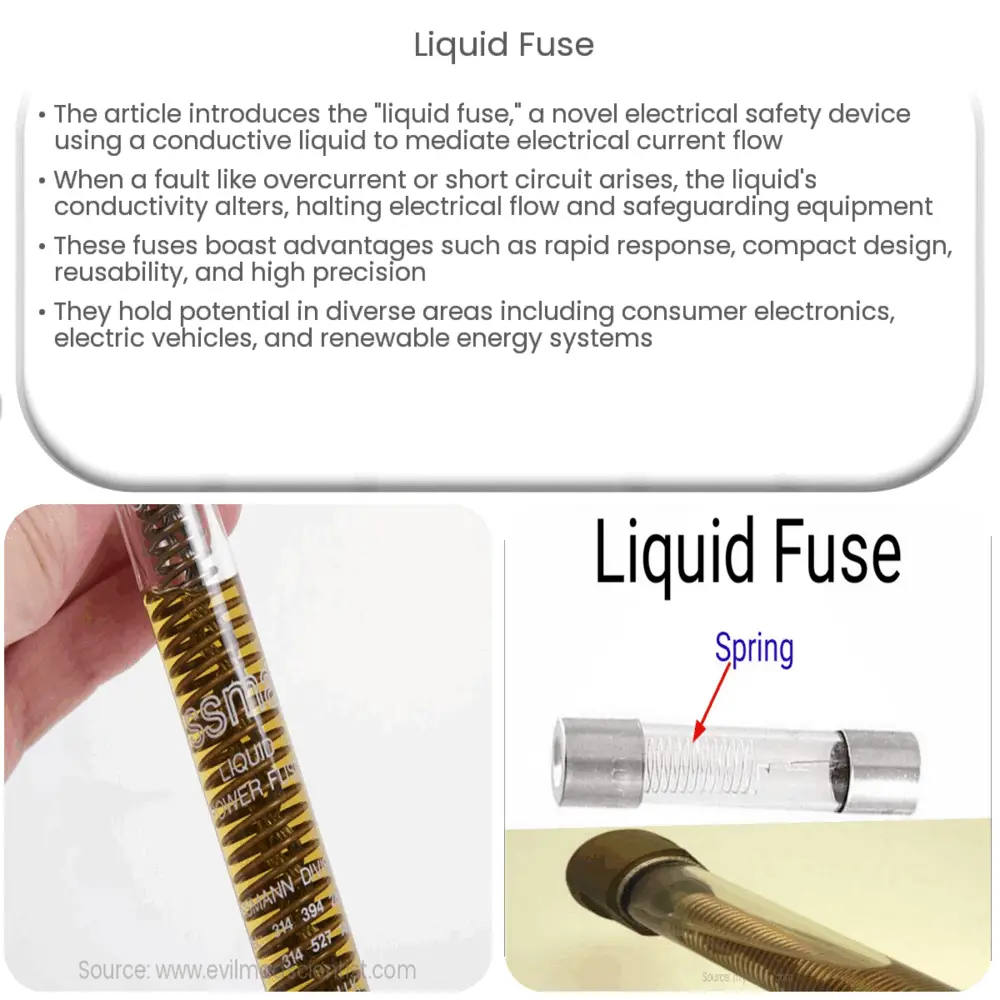Liquid fuses are compact, resettable electrical safety devices that use conductive liquids to interrupt current flow during overcurrent or short circuit events.

Liquid Fuse: An Innovative Approach to Electrical Safety
In recent years, there has been a surge in the development of innovative electrical safety devices aimed at preventing electrical hazards, fires, and equipment damage. One such groundbreaking technology is the liquid fuse. In this article, we will explore the concept of the liquid fuse, its working principle, potential applications, and the advantages it offers over conventional fuses and circuit breakers.
Understanding the Liquid Fuse
A liquid fuse is a type of electrical safety device that utilizes a conductive liquid to serve as a medium for electrical current flow. The liquid in the fuse provides a path for the current to travel through, and when a fault condition occurs, such as an overcurrent or a short circuit, the liquid’s conductivity changes, causing the electrical flow to be interrupted, and thus protecting the connected equipment.
The basic principle behind the liquid fuse is that the conductive liquid’s electrical resistance increases with temperature. Under normal operating conditions, the liquid exhibits low resistance, allowing current to flow smoothly through the circuit. However, when an overcurrent or short circuit condition occurs, the liquid’s temperature rapidly increases, resulting in a significant rise in resistance, which in turn interrupts the electrical flow and isolates the faulty section of the circuit.
Advantages Over Traditional Fuses and Circuit Breakers
Liquid fuses offer several advantages over traditional fuses and circuit breakers. Some of these benefits include:
- Fast Response Time: Liquid fuses have a rapid response time due to the immediate change in the liquid’s conductivity upon reaching a critical temperature. This allows for quicker isolation of faulty circuits and prevents potential damage to connected equipment.
- Compact Size: Unlike conventional fuses and circuit breakers, liquid fuses can be designed in a compact form factor, making them suitable for use in space-constrained applications.
- Resettable and Reusable: Traditional fuses must be replaced once they have been activated, while liquid fuses can be reset and reused multiple times. This makes them more environmentally friendly and cost-effective in the long run.
- High Accuracy: Liquid fuses can be engineered to provide precise and reliable protection across a wide range of current and voltage levels, ensuring optimal performance and safety in various applications.
Potential Applications of Liquid Fuses
Liquid fuses have the potential to revolutionize the electrical safety landscape, and their versatile nature makes them suitable for a variety of applications, including:
- Consumer electronics, such as smartphones, laptops, and gaming consoles
- Electric vehicles and charging infrastructure
- Industrial equipment and machinery
- Renewable energy systems, including solar panels and wind turbines
As the demand for electrical safety devices continues to grow, the development and implementation of liquid fuses are expected to play a crucial role in shaping the future of electrical protection and safety.
Design Considerations and Challenges
While liquid fuses offer many advantages, there are some design considerations and challenges that need to be addressed to ensure their optimal performance and reliability. These include:
- Material Selection: The choice of conductive liquid is critical, as it must exhibit a predictable change in resistance with temperature, be non-toxic, and have good thermal and chemical stability. Researchers are exploring various materials, including ionic liquids, conductive polymers, and nanofluids, to determine the most suitable option for different applications.
- Thermal Management: The thermal management of liquid fuses is crucial to ensure consistent performance and prevent damage to the device due to overheating. Designers must consider factors such as heat dissipation, heat capacity, and thermal conductivity when developing liquid fuses.
- Sealing and Encapsulation: Ensuring proper sealing and encapsulation of the liquid fuse is essential to prevent leakage and contamination of the conductive liquid. This requires the use of robust materials and seals that can withstand high temperatures and pressures.
Regulations and Standards
As with any new technology, it is important for liquid fuses to comply with established electrical safety standards and regulations. This includes obtaining necessary certifications, such as UL, CE, and IEC, to ensure their safe and reliable operation in various applications. Additionally, industry-specific standards may also need to be developed or adapted to accommodate the unique characteristics of liquid fuses.
Conclusion
Liquid fuses represent a promising advancement in electrical safety technology, offering numerous benefits over traditional fuses and circuit breakers. Their fast response time, compact size, reusability, and high accuracy make them an attractive solution for a wide range of applications, from consumer electronics to renewable energy systems. As research and development in this field continue, it is expected that liquid fuses will become an integral component of electrical safety systems, providing enhanced protection and reliability for various industries and consumers alike.

